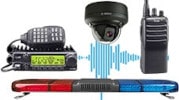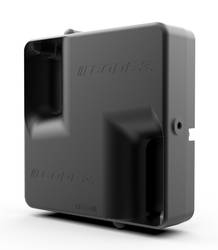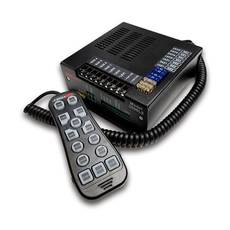- Special Offers
- Transceiver Radio
- Transceiver Accessory
- Antennas
- Antenna Accessory
- Cable
- Connector
- Installation Material
- Installation Tools
- Measuring Equipement
- Body Worn Camera
- Electrosmog
- Telephone
- Baby Monitor
- Fever Thermometer
- Radio Device
- Set-top Boxes
- Personal Protective Equipment
- Motorcycle Helmet Speaker
- Car Equipment
- Voltage Converter
- Dry Cell
- Battery
- Battery Charger
- Emergency Signal
- Amber Signal
- Sound Signal
- Siren Loud Speaker
- Siren
- Light and Sound Signal Accessory
- Traffic Engineering
- LED Lamp
- Smart Home
- Mosquito Repellent Device
- Market - Other Products
- Discontinued Products
Sound Signal
- further categoriesVehicle distinguishing signs are equipped with light and sound signals. The audible warning is an integral part of the distinctive sign, and is used to alert road users and pedestrians to the approach of this type of vehicle.
The siren allows the car with the audible warning to be detected as soon as possible, thus helping it to move quickly. Its purpose is to protect human life, limb, health, property and the environment against threats and to fulfil obligations under national treaties, such as national defence, damage control, public safety and the priority performance of tasks in the interests of the State.
Requirements for distinctive audible warning
For the safety of persons on duty, an attention-grabbing audible warning is required that provides an appropriate volume. The audible warning of the siren, with a variable pitch, measured at a distance of 7 metres in front of the vehicle, is between 103 dB(A) and 120 dB(A). The further detailed sound requirements, testing and qualification of the siren are specified in MSZ 07-4009:1982.
Components of the audible warning
The essential components of the audible alarm are the loudspeaker and the audible alarm control, including the air horn in the case of fire engines. In vehicles using a distinctive signal, the audible and visual signals can be controlled from a siren controller in most cases, allowing the distinctive signal to be controlled quickly and effectively depending on traffic.
Who can use a siren sound signal?
Organisations using a distinctive signal are subject to IRM Regulation 12/2007 (13.III), which regulates its use in detail. Below are some examples:
- The siren facilitates the rapid and unimpeded passage of vehicles of the National Ambulance Service, the Hungarian Defence Forces and law enforcement agencies providing emergency medical care in the event of a life-saving operation.
- The role of the siren is indispensable in alerting the municipal fire brigade and the main fire brigade of the establishment when it is required to respond as quickly as possible to fire-fighting and fire safety incidents.
- The use of a loudspeaker is essential for the professional disaster management bodies and the Inter-ministerial Coordination Committee for Disaster Management to take prompt action in the event of a disaster or emergency.
- Direct intervention on the spot within the law enforcement tasks of the National Tax and Customs Administration.
- The prison authorities and the National Police Headquarters are responsible for the safe and unhindered transport, escort and guidance of prisoners.
- The counter-terrorism agencies are responsible for conducting reconnaissance and object protection activities.
- To ensure the safe and unhindered conduct of mine rescue services.
- It is required by the Directorate General for Public Procurement and Supply, the Ministry of Defence and the Ministry of Foreign Affairs and Trade for the performance of tasks of public interest.
- The loudspeaker is an indispensable accessory for the Hungarian Defence Forces special fire brigade unit to ensure that the alarm is raised as quickly as possible.
- To make the expressway operator's road safe for traffic.
- A siren is necessary for the execution of tasks requiring direct intervention on the spot by the police, traffic police and border police.
Where should sirens be installed to increase safety?
There are some vehicles with distinctive markings where the siren is placed in the light bridge for the safety of the equipment. In this case, the siren is not only used to sound a warning signal, but also to act as a loudspeaker so that the occupants of the car can communicate with the people around the car. There are also hand-held loudspeakers, which are only used to give instructions to the authority.
Is it possible to customise or adjust the sound of sirens?
Since each authority's distinctive signal emits a different sound, it is necessary to adjust the speakers precisely and accurately. Modern sirens manufactured today already have a built-in amplifier and speaker. They are made of fibreglass ABS and injection-moulded aluminium.
These sirens usually have 16 pre-programmed tones, from which it is easy to select the one required by the authority or public body. Setting the specific tone is very simple, it is done by means of micro switches on the back of the siren.
What power source do sirens require?
Modern sirens have outstanding durability and reliability. A distinctive feature of these sirens is that they must be connected to the car battery. The control unit should be located in the engine compartment, where it is fully protected from weather conditions and rising water.
In general, sirens of this type are equipped with 100 W high-powered loudspeakers with an impedance of 11 Ohms. The operating temperature of the sirens is specified by the manufacturers as between -20°C and +85°C, meaning they can be used safely in winter and summer, in snowfall and in the hottest of climates. Because they are lightweight, usually between 0.5 and 1 kg, they are easy to install in light bridges.
Browse our range of audible alarms and don't hesitate to contact us if you need expert help!



